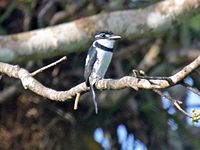
The red-billed blue magpie is a species of bird in the crow family, Corvidae. It is about the same size as the Eurasian magpie, but has a much longer tail, one of the longest of any corvid. It is 65–68 cm (25.5–27 in) long and weighs 196–232 g (6.9–8.2 oz).

The black-headed lapwing or black-headed plover is a large lapwing, a group of largish waders in the family Charadriidae. It is a resident breeder across sub-Saharan Africa from Senegal to Ethiopia, although it has seasonal movements. It lays two or three eggs on a ground scrape.

The white-naped woodpecker is woodpecker which is a widespread but a scarce breeder in the Indian Subcontinent. It is associated with open forest and scrub with some trees. It nests in a tree hole, laying one or two white eggs.
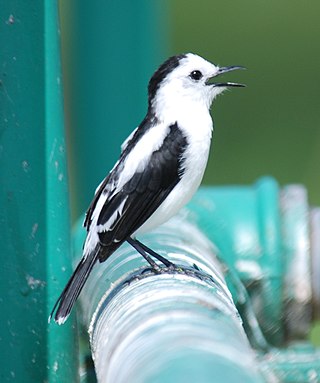
The pied water tyrant is a small passerine bird in the tyrant flycatcher family. It breeds in tropical South America from Panama and Trinidad south to Bolivia.

The great-billed parrot also known as Moluccan parrot or island parrot, is a medium-sized, approximately 38 cm long, green parrot with a massive red bill, cream iris, blackish shoulders, olive green back, pale blue rump and yellowish green underparts. The female is typically smaller than the male, but otherwise the sexes are similar.

The Madagascar ibis, also known as the Madagascar crested ibis, white-winged ibis or crested wood ibis, is a medium-sized, brown-plumaged ibis. It has bare red orbital skin, yellow bill, red legs, white wings and its head is partially bare with a dense crest of green or gloss blue and white plumes on the nape. The Madagascar ibis is the only member of the genus Lophotibis.

The grey-breasted sabrewing is a species of hummingbird in the "emeralds", tribe Trochilini of subfamily Trochilinae. It is found in Bolivia, Brazil, Ecuador, the Guianas, Peru, and Venezuela.

The rufous nightjar is a species of nightjar in the family Caprimulgidae. It is found in Argentina, Bolivia, Brazil, Colombia, Costa Rica, Ecuador, Guyana, Panama, Paraguay, Peru, Saint Lucia, Suriname, Trinidad and Tobago, and Venezuela.
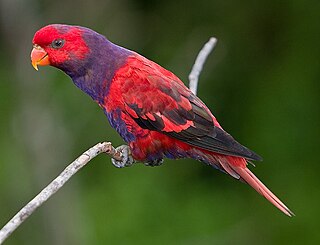
The violet-necked lory is a species of parrot in the family Psittaculidae. It is endemic to Indonesia, where it is found in the northern Maluku Islands and west Papuan islands. Its natural habitats are tropical moist lowland forests and tropical mangrove forests.

The spotted rail is a species of bird in the subfamily Rallinae of the rail, crake, and coot family Rallidae. It is found in Mexico, Central America, the Caribbean, and South America.

The yellow-breasted crake is a species of bird in subfamily Rallinae of family Rallidae, the rails, gallinules, and coots. It is found on several Caribbean islands and in most of Central America and South America.

The variegated antpitta is a species of bird in the family Grallariidae. It is found in southeastern Brazil, eastern Paraguay, the Guianas and the northern Amazon Basin. Its range extends to Venezuela in the northwest; in the Amazon Basin, it is found in the downstream half of the basin, as well as in the Atlantic outlet region of the neighboring Tocantins-Araguaia River drainage to the southeast. A minor disjunct population is in Peru, and an Argentinian population is found in the tongue of land between Paraguay and southern Brazil.
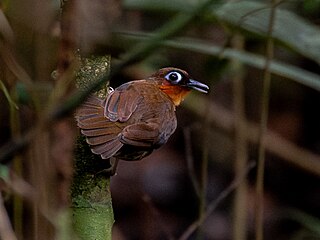
The rufous-throated antbird is a species of bird in the family Thamnophilidae. It is found in Brazil, French Guiana, Guyana, Suriname, and Venezuela. Its natural habitat is subtropical or tropical moist lowland forests.

The wing-banded antbird is a species of passerine bird in subfamily Myrmornithinae of family Thamnophilidae, the "typical antbirds". It is found in Brazil, Colombia, Ecuador, French Guiana, Guyana, Nicaragua, Panama, Peru, Suriname, and Venezuela.

The hooded tanager is a species of bird in the tanager family Thraupidae. It is found in Argentina, Bolivia, Brazil, Colombia, French Guiana, Guyana, Paraguay, Peru, and Venezuela. Its natural habitats are subtropical or tropical moist lowland forest, subtropical or tropical mangrove forest, and heavily degraded former forest.
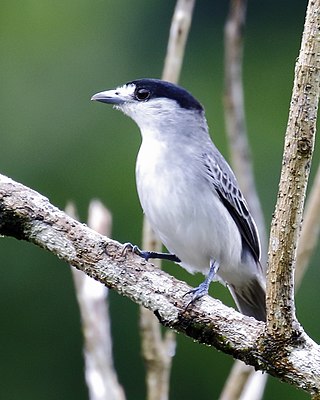
The cinereous becard is a species of bird in the family Tityridae. The term cinereous describes its colouration. It has traditionally been placed in Cotingidae or Tyrannidae, but evidence strongly suggest it is better placed in Tityridae, where it is now placed by the South American Classification Committee.

The rusty-collared seedeater is a species of bird in the family Thraupidae, formerly placed in the related Emberizidae.

The olive woodpecker is a species of bird in the woodpecker family Picidae.
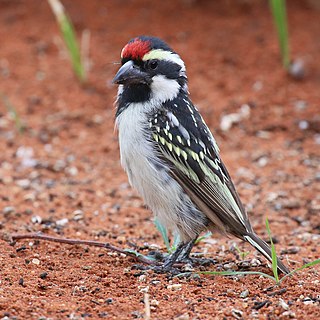
The acacia pied barbet or pied barbet is a species of bird in the family Lybiidae which is native to southern Africa.

The mangrove rail is a species of bird in subfamily Rallinae of family Rallidae, the rails, gallinules, and coots. It is found in Central and South America.




